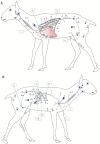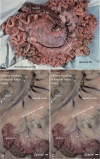Characterisation of ovine lymphatic vessels in fresh specimens
- PMID: 30650093
- PMCID: PMC6334992
- DOI: 10.1371/journal.pone.0209414
Characterisation of ovine lymphatic vessels in fresh specimens
Abstract
Background and aim: The development and use of experimental models using lymphatic cannulation techniques have been hampered by the lack of high-quality colour imaging of lymphatic vessels in situ. Most descriptions of lymphatic anatomy in sheep have historically depended on schematic diagrams due to limitations in the ability to publish colour images of the lymphatic vessels with decent resolution. The aim of this work was to encourage more widespread use of the ovine cannulation model by providing clear photographic images identifying the location and anatomical layout of some major lymphatic ducts and their in situ relationship to surrounding tissues.
Methods: The cadavers of the sheep were collected after they had been euthanized at the end of animal trials not associated with this study. The lymphatics were dissected and exposed to show their appearance in the surrounding tissues and their relationship to other organs. Patent Blue was used to locate lymphatic vessels in exploratory preparations. However, in order to present the natural appearance of the vessels, we used minimal dissection and dye was not used for the photographed examples. Instead, we have indicated the course of the vessels with lines where their position is less clear.
Results and conclusion: In this paper, we have used sheep specimens as examples to show characteristic images of lymphatic vessels. The images of in situ lymphatics and lymph nodes combined with schematic summaries provide a concise illustration of the lymphatic drainage scheme in sheep.
Conflict of interest statement
The authors have declared that no competing interests exist.
Figures






References
MeSH terms
LinkOut - more resources
Full Text Sources

